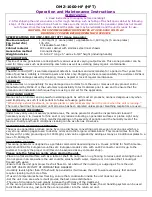
1-11-2-2-12
1
1
Two tubes arranged together
Liquid tubing
Gas tubing
Insulation
CAUTION
If the exterior of the outdoor unit valves has been finished with a
square duct covering, make sure you allow sufficient space to
access the valves and to allow the panels to be attached and
removed.
Additional Precautions For R32 Models.
Ensure to do the re-flaring of pipes before connecting to
units to avoid leaking.
To prevent the ingress of moisture into the joint which could have the
potential to freeze and then cause leakage, the joint must be sealed
with suitable silicone and insulation material. The joint should be
sealed on both liquid and gas side.
Insulation material and silicone sealant.
Please ensure there are no gaps where moisture can enter the joint.
Silicone Sealant must be neutral cure and ammonia free. Use of silicon
containing ammonia can lead to stress corrosion on the joint and cause
leakage.
T
aping the flare
nuts
Wind the white insulation tape around the flare nuts at the gas tube
connections. Then cover up the tubing connections with the flare
insulator, and fill the gap at the union with the supplied black insulation
tape. Finally, fasten the insulator at both ends with the supplied vinyl
clamps.
Flare insulator (supplied)
Tube insulator (not supplied)
Heat resistant 120°C or above
Flare union
Flare nut
Unit side
Insulation material
The material used for insulation must have good insulation characteristics,
be easy to use, be age resistant, and must not easily absorb moisture.
CAUTION
After a tube has been insulated, never try to bend it into a narrow
curve because it can cause the tube to break or crack.
Never grasp the drain or refrigerant connecting outlets when
moving the unit.
Taping the Tubes
(1)
At this time, the refrigerant tubes (and electrical wiring if local codes
permit) should be taped together with armoring tape in 1 bundle.
To prevent condensation from overflowing the drain pan, keep the
drain hose separate from the refrigerant tubing.
Wrap the armoring tape from the bottom of the outdoor unit to the
top of the tubing where it enters the wall. As you wrap the tubing,
overlap half of each previous tape turn.
Clamp the tubing bundle to the wall, using 1 clamp approx. each
meter.
Interconnecting refrigerant
pipework, i.e. pipework external
to the unitary components,
should be marked with a Class
label (see right figure) every two
metres where the pipework is
visible.
Label size is 50 mm × 50 mm.
This includes pipework located
in a ceiling space or any void
which a person may access for
maintenance or repair work
within that space.
(2)
(3)
(4)
Insulated tubes
Drain hose
Clamp
NOTE
Do not wind the armoring tape too tightly since this will decrease the
heat insulation effect. Also ensure that the condensation drain hose
splits away from the bundle and drips clear of the unit and the tubing.
Finishing the Installation
After finishing insulating and taping over the tubing, use sealing putty
to seal off the hole in the wall to prevent rain and draft from entering.
Apply putty here
Tubing
NOTE
See “Section 2. TEST RUN”.
HOW TO INSTALL THE TIMER REMOTE
CONTROLLER OR HIGHSPEC WIRED REMOTE
CONTROLLER (OPTIONAL PART)
Accessories Supplied with Unit
Part Name
Figure
Q’ty
Remarks
Special
washer
8 For indoor unit
suspension
Insulator
2 For gas and liquid tubes
Drain hose
1
Hose band
1 For securing drain hose
Drain
insulator
1
Connection
tubing
1 ø19.05
→
ø25.4
Only type 200/224
Clamper
2 For power supply code /
control wiring
Operating
Instructions
1
Installation
Instructions
1
•
Use M10 or 3/8” suspension bolt. (field supply)
Type of Copper Tube and Insulation Material
If you wish to purchase these materials separately from a local source,
you will need:
1. Deoxidized annealed copper tube for refrigerant tubing.
2. Foamed polyethylene insulation for copper tubes as required to
precise length of tubing.
Insulation material thickness must be 10 mm or greater.
3. Use insulated copper wire for field wiring. Wire size varies with the
total length of wiring.
See section “
1-10. ELECTRICAL WIRING
” for details.
1. Refrigeration (armored) tape
2. Insulated staples or clamps for connecting wire (See your local codes.)
3. Putty
4. Refrigeration tubing lubricant
5. Clamps or saddles to secure refrigerant tubing
6. Scale for weighing
CAUTION
Check local electrical codes and regulations before obtaining wire.
Also, check any specified instructions or limitations.
Additional Materials Required for Installation
SM830277-00_大洋州向け R32シングル_TD&SM.indb 12
2019/02/27 11:51:09
Содержание S-160PE1R5B
Страница 12: ...MEMO Xi SM830277 00_ R32 _TD SM indb 12 19 02 26 9 34 28...
Страница 136: ...MEMO 2 16 SM830277 00_ R32 _TD SM indb 16 19 02 28 13 25 27...
Страница 138: ...3 2 3 3 1 Outdoor Units Electric Wiring Diagram U 160PZH2R5 SM830277 00_ R32 _TD SM indb 2 19 02 12 9 55 27...
Страница 140: ...3 4 3 3 2 Indoor Units Ducted Type S 160PE1R5B Electric Wiring Diagram SM830277 00_ R32 _TD SM indb 4 19 02 12 9 55 28...
Страница 160: ...4 18 4 4 3 Outdoor Unit HIC Board U 160PZH2R5 ACXA73 2760 SM830277 00_ R32 _TD SM indb 18 19 02 21 11 54 24...
Страница 161: ...4 19 4 U 160PZH2R8 U 180PZH2R8 U 200PZH2R8 U 224PZH2R8 ACXA73 3104 SM830277 00_ R32 _TD SM indb 19 19 02 21 11 54 24...
Страница 164: ...MEMO 4 22 SM830277 00_ R32 _TD SM indb 22 19 02 21 11 54 26...
Страница 202: ...MEMO 5 38 SM830277 00_ R32 _TD SM indb 38 19 02 28 13 37 39...
Страница 274: ...201903 SM830277 00_ R32 _TD SM indb 1 19 02 12 9 03 53...
















































